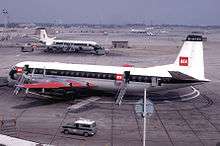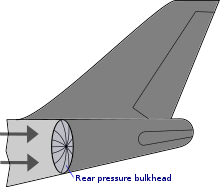British European Airways Flight 706
British European Airways Flight 706 (BE706/BEA706) was a scheduled flight from Heathrow Airport in London, United Kingdom to Salzburg-W. A. Mozart Airport in Salzburg, Austria. The flight was operated by a Vickers Vanguard with a U.K registration of G-APEC. On 2 October 1971, whilst en route at 19,000 ft (5,791 m), 35 minutes after takeoff,[1] the rear cabin pressure bulkhead failed. The resulting pressurisation of the tail section caused the surfaces of the tailplanes to separate, weakening them to the point that they broke off. Without a horizontal stabiliser the aircraft entered an uncontrollable dive. The aircraft crashed near Aarsele, Belgium, killing all 63 passengers and crew on impact.[2] A piece of debris from the aircraft struck a passing car, causing minor injuries to one of its occupants.
 G-APEC at London Heathrow in 1965. | |
| Accident | |
|---|---|
| Date | 2 October 1971 |
| Summary | Explosive decompression, leading to structural failure and loss of control |
| Site | Aarsele, Belgium |
| Aircraft type | Vickers Vanguard |
| Operator | British European Airways |
| Registration | G-APEC |
| Flight origin | Heathrow Airport, London, United Kingdom |
| Destination | Salzburg Airport, Salzburg, Austria |
| Occupants | 63 |
| Passengers | 55 |
| Crew | 8 |
| Fatalities | 63 |
| Survivors | 0 |
| Ground casualties | |
| Ground injuries | 1 |
Investigators, in attempting to determine the cause of the accident, found corrosion in the lower part of the rear pressure bulkhead underneath plating that was bonded to the structure. The bulkhead had been eaten away. Fluid contamination, perhaps from the lavatory, was thought to have been the root cause for the corrosion.[3] The corrosion was not detectable by then-current inspection techniques. The Belgian Civil Aeronautics Administration wrote the report and the British Air Accidents Investigation Branch had accredited personnel assisting the investigation.[4]
Flight
Flight 706 took off from Runway 28 L of London Heathrow Airport at 09:34 local time with 55 passengers and 8 crew members[5].. After take off, Flight 706 was routed via Epsom, Biggin and Detling in accordance to the "Dover One" standard instrument departure clearance. The crew of Flight 706 later reported over the Dover VOR at 09:54 local time. At the time, Flight 706 was climbing through 14,200 feet. At 10: 01, the communication was handed over to Brussels Air Traffic Control.[6]
- 10:01 BEA706: "Goodmorning Brussels Bealine seven oh six is passing one eight for one nine zero and estimating Wulpen at zero hour"
- 10:01 ATC: "Seven oh six cleared er Salzburg green one to maintain flight level one nine zero on reaching "
- 10:01 BEA706: "Bealine seven oh six"
The crew then reported passing over the Wulpen VOR with the aircraft level at FL190.[5]
- 10:05 BEA706: "Brussels Bealine seven oh six checked Wulpen zero four we're now level one nine zero estimating Mackel one zero"
- 10:05 ATC: "Seven oh six roger"
Five minutes after this communication, the crew of Flight 706 transmitted "we're going down, 706, we are going down" to Brussels Tower. The crew later declared emergency and called "mayday, mayday" several times. The crew also stated the phrase "out of control" several times. At one point, they stated that there was no rudder control. Their calls were accompanied by several background voices.[5][6]
- 10:09:46 BEA706: "We're going down, 706, we're going down Mayday Mayday Mayday
- 10:09 BEA706: "Mayday Mayday Mayday we're going down vertically"
- 10:09:55 BEA706: "Bealine seven zero six (inaudible) out of control"
- 10:09:58 BEA706: "No rudder-- (inaudible)"
- 10:10:11 BEA706: "AAH! This is it--"
The last transmission from Flight 706 was recorded at 10:10:30. Brussels Tower immediately attempted contacting Flight 706 several times. However, there were no answers from Flight 706.[5] Witnesses on the ground saw the tailplane of Flight 706 detached and subsequently Flight 706 entered a nose-dive. The flight kept diving and crashed into farm land near Aarsele, Belgium and exploded on impact. All 55 passengers and 8 crew members were killed. At least one person on the ground was injured after pieces of the debris struck a passing car.[5]
Rescue services were immediately dispatched. Investigators were deployed and immediately searched the aircraft's black box. A crisis center was set up in Salzburg for the relatives of the victims of Flight 706. Searchers stated that most of the bodies were not intact. One searcher said “as for the bodies, what we have found so far is barely enough to reconstitute one body.[7]”
Passengers and crews
The aircraft was carrying 55 passengers and 8 crew members. News report stated that there were 37 British passengers on board the aircraft. At least 4 Japanese and 11 Americans were also on board the aircraft. Further reports also confirmed the presence of 8 Austrians on board the flight.[8][9] Two notable fatalities among the passengers were the British hat designer Otto Lucas and an Austrian academic, René Marcic.[10]
The Captain was identified as 40 year old Captain E.T Probert. At the time of the accident, he had accumulated a total flying hours of 9,260 hours, in which 1,927 hours were on the type. The co-pilot was 38 year old J.M Davies, who held a Vickers Vanguard rating. He had a total flying hours of 3,386 hours, in which 764 hours were on the type. The aircraft was also carrying a third pilot, identified as 27 year old B.J.S Barnes with a total flying hours of 2,237 hours, in which 1,903 hours were on the type and a supernumerary, identified as Captain G. Partridge.[5]
Investigation
Witnesses on the ground recalled that the Vanguard suddenly exploded in mid-air, lost one of its wings, and plunged onto the ground, with smoke pouring out from one of its wings. They stated that they heard strange noises during the crash. According to them, the aircraft touched down in one field, jumped a road, and plowed through grassland for 500 yards. It gouged into the ground and burst into flames in a pit 15 feet deep. One of the witness stated, “The fire spread from the wreckage like waves," Police said eyewitness reports indicated that Captain Probert had tried to execute an emergency landing.[8]
There was considerable suspicion that the aircraft had been sabotaged by extremists. A BEA spokesman claimed that the aircraft was sabotaged by Northern Ireland extremists. The Vanguard had been used on the London‐Belfast route, though he said the plane had not been on Belfast service for at least 48 hours and was stored in Edinburgh on Friday. However, after a preliminary investigation by William Trench, one of the investigators from AIB, stated that at the time there was no hint that sabotage played a part in the crash.[10]
Flight recorder analysis
Investigators recovered the flight recorder from the crash site. The flight recorder was later taken to United Kingdom for further analysis. After investigators downloaded the content, they found that the recordings stopped abruptly while the aeroplane was still in mid-air. Investigators concluded that a sudden explosive decompression caused this abrupt stop of the recordings.[5]
Structural failure

Detailed examination showed that the failure of the rear pressure bulkhead started the sequence of structural failure of Flight 706. The rapid inflation of the tailcone and empennage imposed a high differential pressure across the tailplane skin. This caused the upper panel to become detached from the main structure. The aircraft's flight load then caused the rapid break up and separation of the aircraft's tailplane from its main body. This separation of the tailplane caused the aircraft to pitch rapidly nose down. Investigators stated that recovery from this dive was impossible.[5]
Investigators found severe corrosion at the joint of the fuselage skin and the rear pressure bulkhead. This crack was hidden and probably was not detected by maintenance crew for a period of time. The crack was probably developed after a long period, evidenced by the presence of nicotine tar stains found on the crack. Further analysis from the nature of the progressive tear marks on the fracture surfaces suggests that the period was short.[5]
Investigators concluded that the crack affected the structural integrity of the aircraft.[5]
Inspection
In their final report, investigators stated,[5]
"The approved maintenance schedule called for visual inspection of the bulkhead at relatively long intervals. This approach assumed that the bonding paint and sealing schemes remained intact and effective. In fact, delamination accompanied by corrosion can occur between the redux bonded doubler and the front face of the pressure bulkhead. The corrosion attack may be severe before any visual indication is apparent at the edge of the bonded doubler."
Examination from the aircraft's maintenance record showed that maintenance crew had conducted a radiographic examination of the rear pressure bulkhead of the aircraft prior to the accident. However, investigators questioned the effectiveness of the technique. The technique used to examine this particular area (the rear pressure bulkhead) of the Vanguard has since been demonstrated to be ineffective as a sure means of detecting corrosion. This is because of the difficulty of interpreting the photographic plate details resulting from the complex structure. With the inspection technique then in use, investigators concluded that the corrosion on the aircraft was not detectable.[5]
The crack was located near the toilet of the aircraft. Investigators stated that they found liquid around the crack. Appreciable amounts of liquids had been retained at various times in the structure aft of the rear pressure bulkhead. Because of BEA practice of employing personnel to clean the aircraft, this could cause the inspector to be unaware of possible fluid contamination on the aircraft.[5]
Conclusion
Investigators finally concluded the cause of the accident, and stated,[5]
"The accident was caused by the rupture of the rear pressure bulkhead, which led to the separation both tailplanes in flight and caused the aircraft to dive into the ground,"
Aftermath
British European Airways immediately implemented a new technique in detecting corrosion. It was later revealed that eight Vanguards of their fleets suffered the same crack as G-APEC.[5]
References
- "BEA Vanguard Lost." Flight International. 7 October 1971. p. 557.
- "63 persons are killed in fiery air accident." United Press International (UPI) at the Wilmington Star-News. Sunday 3 October 1971. Volume 42, No. 5. One-A. Retrieved from Google News, 1 of 26, on 19 May 2014.
- Aviation Safety Network Aircraft accident Vickers 951 Vanguard G-APEC Aarsele
- "Vanguard Report Issued." Flight International. 11 January 1973. p. 51
- "Final Report G-APEC" (PDF).
- "Final Report of G-APEC (Appendixes)" (PDF).
- "Desert Sun, Number 51, 2 October 1971". Desert Sun.
- "All 63 on British Airliner Killed in Crash in Belgium". The New York Times.
- "1971, News: British European Airways Flight 706 crashes near Aarsele, Belgium".
- "Tail pieces found 3 miles from Belgium air crash". Bangor Daily News. UPI. 4 October 1971. Retrieved 22 September 2014.
External links
- British European Airways Vanguard G—APEC. Report on the accident which occurred at Aarsele, Belgium on 2 October 1971" (Archive). The Kingdom of Belgium Ministry of Communications, Civil Aeronautics Administration. Re-published by the Accidents Investigation Branch, Department of Trade and Industry as Civil Accident Report No EW/A224, Report 15/72. – Official accident report.
- Video of the crash site, Associated Press